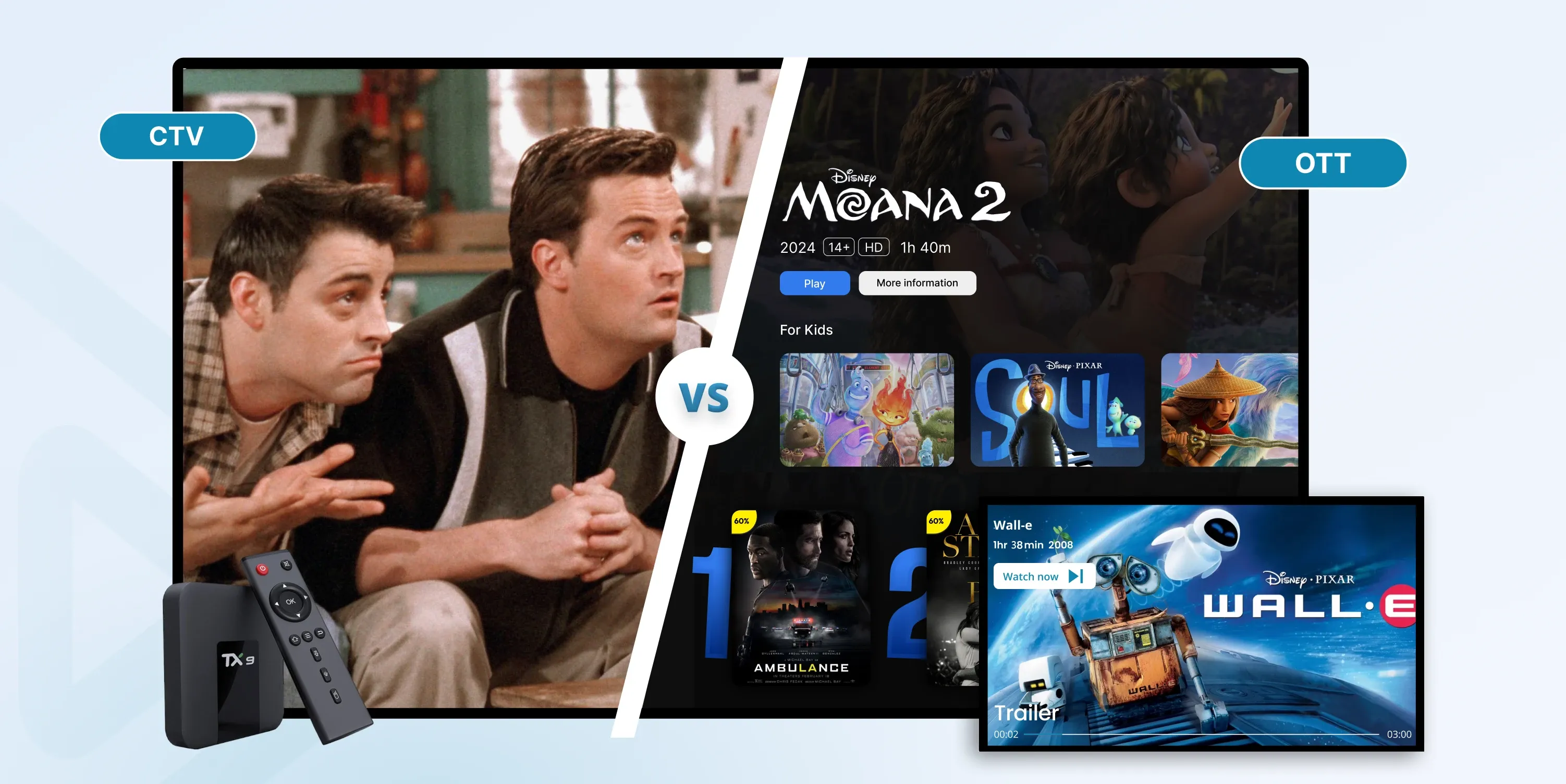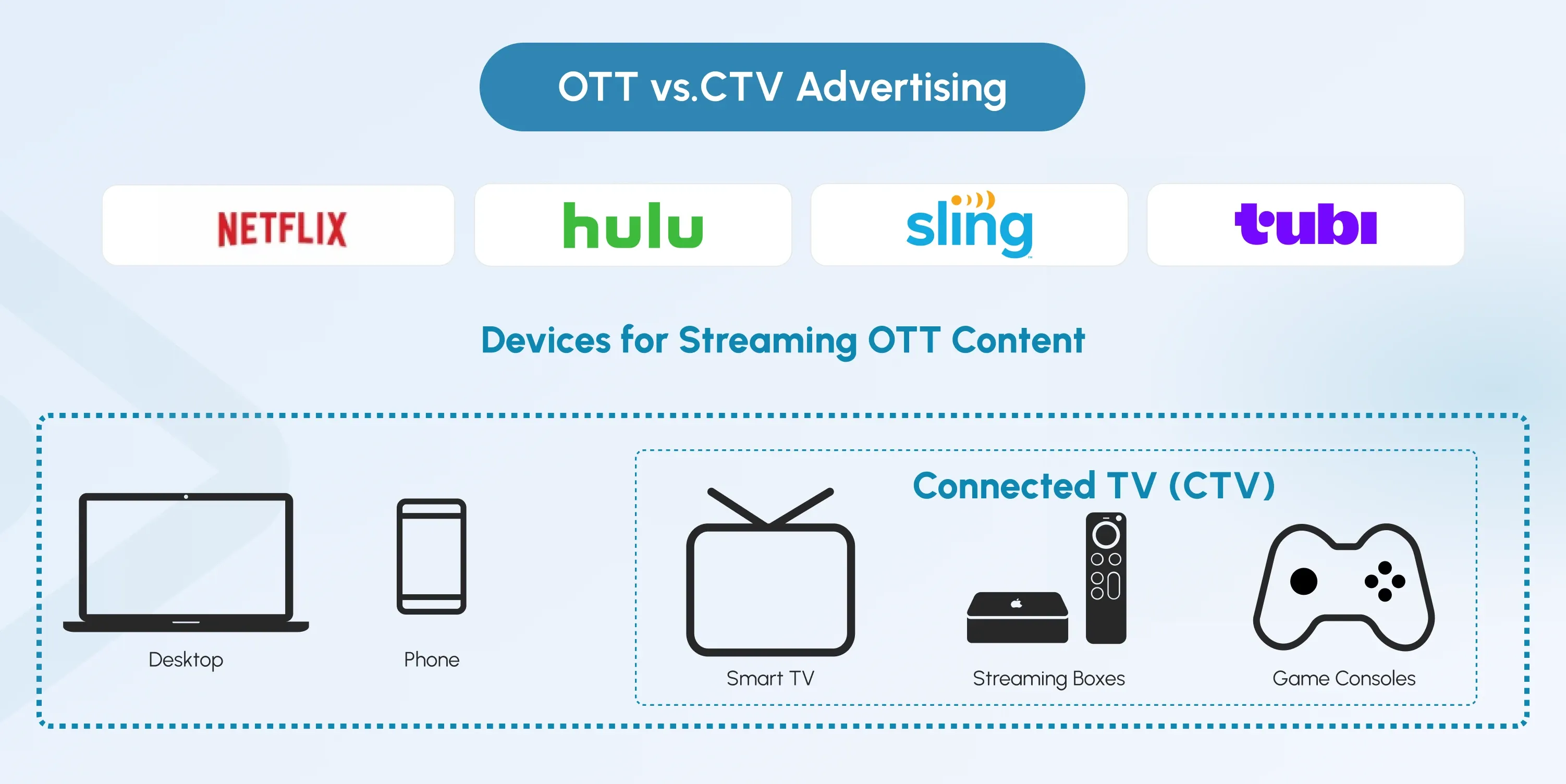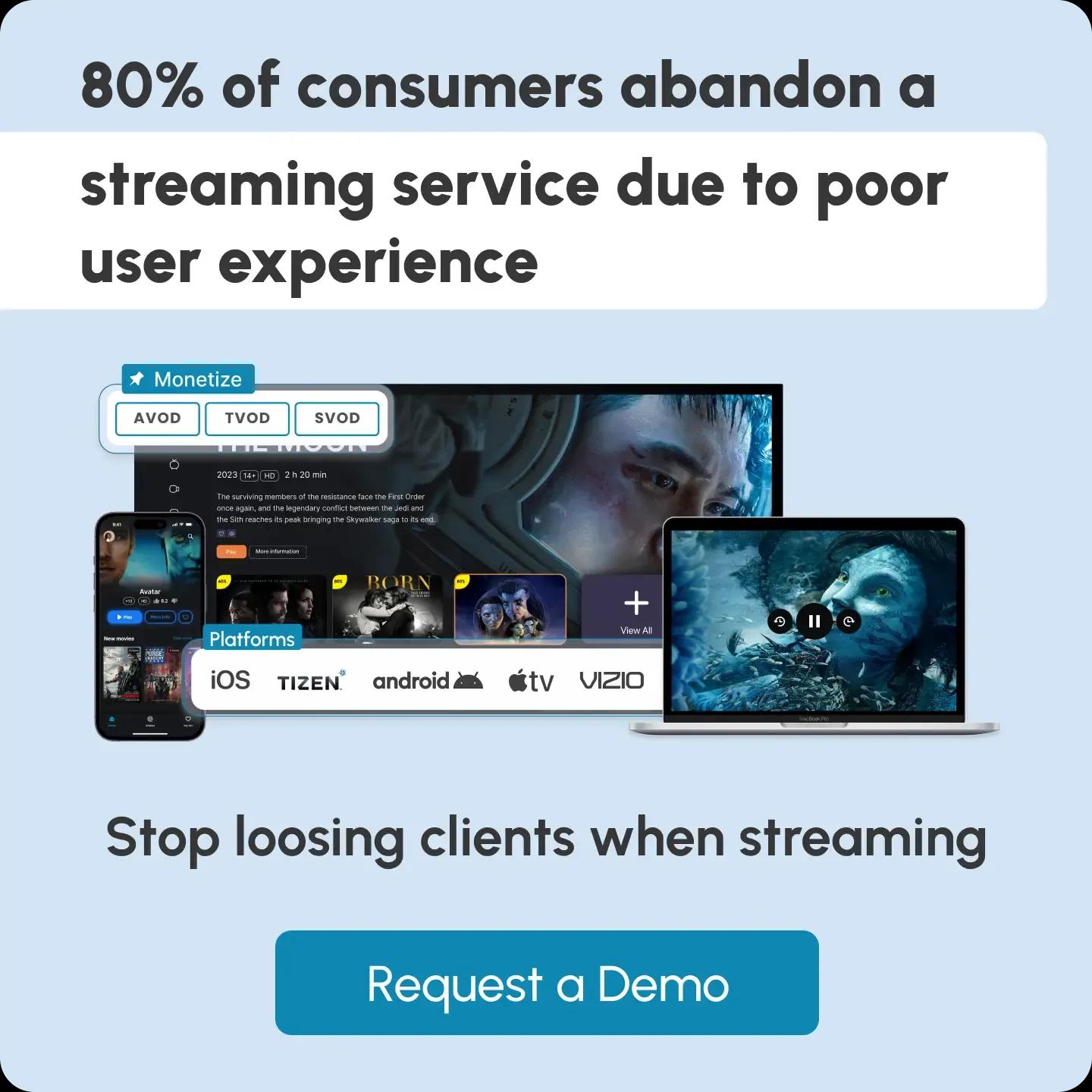
OTT vs CTV: Main Differences, Benefits and How to Choose
Whether you're an advertiser, a marketer, or a content creator, understanding the difference between OTT and CTV is essential for making the right choice for your campaigns. Why? Simply because it will give you a clear picture of strategies, benefits, and, why not, challenges you will face in the future.
In this article, we’ll dive into OTT vs CTV, explore their differences, and share expert insights to help you decide which platform aligns best with your advertising goals.

What is OTT?
OTT stands for over-the-top, a term used to describe the process of content streaming —such as videos, music, or games—over the internet without needing a traditional cable or satellite TV service.
What does OTT stand for in streaming? In the streaming context, OTT refers to delivering video content directly over the internet to viewers, bypassing traditional distribution channels like cable or satellite TV.
Examples of OTT platforms: Netflix, Hulu, Amazon Prime, HBO, YouTube, and Disney+
These OTT platforms allow viewers to stream their favorite shows and movies directly to their devices. So, if you're watching Netflix on your smartphone or laptop, you’re engaging with OTT content.
What is CTV?
Connected TV (CTV) refers to any television set that connects to the internet directly or through an external device like a streaming stick or gaming console.
So, what does CTV stand for in media? With CTV, viewers can stream OTT content directly on their TV screens. For instance, if someone watches a series on Netflix using an Apple TV, they’re using a CTV device to access OTT content.
Examples of CTV devices: Apple TV, Amazon Fire TV Stick, Roku, and gaming consoles like Xbox.
Key Differences Between OTT and CTV
| Feature | OTT | CTV |
|---|---|---|
| Definition | OTT is an app or service that delivers content over the internet. | CTV is the internet-enabled TV or TV plug-in device used to watch or consume OTT content. |
| Platforms Available | OTT platforms include streaming service providers like Netflix, Disney+, Hulu, and YouTube. | CTVs are compatible with OTT platforms but consist of devices such as TV sticks, smart TVs, or gaming consoles. |
| Delivery Methods | Offers advanced targeting capabilities based on user data, including demographics, interests, and viewing behaviors. This allows advertisers to personalize ads for specific audiences, making the advertising experience more targeted and relevant. | Offers advanced targeting capabilities based on user data, including demographics, interests, and viewing behaviors. Advertisers can personalize ads for specific audiences across different devices. |
| Flexibility | OTT enables on-demand access to a wide range of content consumed whenever and wherever. | CTV enhances the traditional TV viewing experience by integrating digital streaming services and apps onto TV screens. |
| Advertising | OTT supports various ad formats, including pre-roll, mid-roll, post-roll, interactive, and personalized ads. It leverages data-driven insights to optimize ad delivery and engagement. | CTV focuses on delivering ads specifically on TV screens, often during streaming sessions. It combines the reach of traditional TV with the precision of digital targeting but may be limited to specific devices. |
| Content Integration | OTT offers diverse content formats from multiple providers, including movies, TV shows, and original programming. | CTV integrates digital streaming services and apps with traditional TVs or TV plug-in devices, providing a hybrid viewing experience across live and on-demand content. |
OTT vs. CTV Advertising
The key difference lies in the platforms and devices where ads are displayed:
OTT Advertising: This can be delivered across multiple devices, providing a versatile ad experience with formats like pre-roll, mid-roll, post-roll, and interactive ads. Advertisers benefit from precise targeting based on user data, including demographics and viewing habits.
 CTV Advertising: Focuses on internet-connected TV screens, offering a more traditional TV-like ad experience. Ads on CTV devices can be longer, like the standard 30-second spots, making them ideal for brand storytelling and creating a more immersive experience for viewers.
CTV Advertising: Focuses on internet-connected TV screens, offering a more traditional TV-like ad experience. Ads on CTV devices can be longer, like the standard 30-second spots, making them ideal for brand storytelling and creating a more immersive experience for viewers.
Both OTT and CTV ads utilize data to target audiences based on demographics, interests, and behaviors, ensuring a more relevant and personalized ad experience.
Benefits of OTT Advertising
OTT advertising is highly effective at capturing viewers’ attention, prompting them to explore products and make additional targeted interactions with the advertised products and services.
Here are three main advantages:
- Highly Targeted and Personalized: OTT platforms leverage user data to deliver highly relevant ads, making them more engaging and effective.
- Flexibility Across Devices: Ads can be displayed on a range of devices, from TVs to smartphones, providing a broad reach.
- Enhanced Viewer Engagement: Statistics show that OTT ads have high recall rates and encourage viewers to take action, such as searching for more information or making a purchase.
For instance:
72% of viewers remember a specific ad they watched on an OTT platform (source: WebFX).
66% discover new products or services through OTT video ads (source: McClatchy).
65% search for information about a product they saw in an OTT ad on a second screen (source: TheVab).
40% of OTT viewers pause content to research or purchase an advertised product (source: OpenX).
OTT video ads are turning out to be one of the most efficient strategies for engaging target audiences in 2024. Even in situations with higher ad recall rates and viewer engagement statistics, OTT vs. CTV ads are still more effective.
OTT offers several advantages, including advanced targeting capabilities, a receptive audience willing to engage with ads, and the potential to drive future actions, such as exploring more content or purchasing.
What are The Benefits of CTV Advertising?
Did you know 87% of U.S. households have at least one CTV device? Leichtman Research Group's (LRG) research shows that a significant audience streams content on a CTV device.
CTV offers several key benefits for advertisers and content providers, leveraging the convergence of traditional television with digital streaming capabilities:
- Large Screen Impact: Ads displayed on TV screens take advantage of high-quality visuals and sound, making them more memorable.
- Broad Audience Reach with Precision: CTV combines the extensive reach of traditional TV with the precise targeting capabilities of digital advertising, allowing advertisers to target specific households based on demographics and viewing habits.
- Integrated Viewing Experience: CTV integrates digital streaming services with traditional TV content, creating a seamless viewing experience that transitions easily between live broadcasts and on-demand content.
By blending the best of both worlds, CTV provides advertisers with a unique opportunity to engage viewers with high-quality, targeted experiences.
OTT vs. CTV: Choosing the Right Platform
The right choice depends on your campaign goals, target audience, and budget. Here are some key factors to keep in mind when selecting the platform that suits your needs:
Targeting Your Audience
CTV is Best For
- Targeting audiences specifically on TV screens.
- Reaching users in a lean-back viewing experience, similar to traditional TV.
- Advertising to households and families primarily watching content on smart TVs and streaming devices.
OTT is Best For
- Reaching a broad audience across multiple devices, including smartphones, tablets, laptops, and desktops.
- Targeting younger and middle-aged demographics who prefer streaming over traditional TV.
- Engaging cord-cutters who have moved away from cable or satellite subscriptions in favor of streaming services.
Analyzing Tools
CTV is Best For
- Measuring ad performance specifically on TV screens.
- Tracking reach, frequency, and viewer demographics to optimize campaigns.
- Analyzing return on investment (ROI) for TV-based advertising.
OTT is Best For
- Accessing real-time analytics across multiple devices.
- Tracking ad impressions, completion rates, and viewer engagement in detail.
- Fine-tuning campaigns with robust measurement tools to maximize effectiveness.
Budget and Cost Considerations
CTV is Best For
- Premium TV advertising with high-quality production value.
- Campaigns that can accommodate a higher initial investment.
- Reaching a broad audience on large-screen, TV-based platforms.
OTT is Best For
- Flexible budgeting, allowing you to adjust spending based on goals and targeting.
- Cost-effective campaigns for reaching niche audiences across multiple digital devices.
- Scalable advertising, making it ideal for businesses of all sizes.
inoRain’s OTT Solutions for Your Business Success
inoRain’s white-label OTT platform helps you create your branded streaming service with no need for technical expertise.
Benefits include:
- Multi-Device Availability: Supports over 10 platforms, including smartphones, tablets, TV boxes, PCs, and smart TVs.
- Multiple Monetization Models: Offers 10+ monetization and revenue generation options, such as AVOD, SVOD, TVOD, and hybrid models.
- Easy-to-Use Dashboard: Allows complete control over streaming content, user management, and analytics.
- In-Depth Analytics: Provides insights into audience behavior and engagement, helping businesses make data-driven decisions.
Ready to take your streaming service to the next level? With inoRain’s powerful and flexible OTT platform, you can launch your own branded service and start reaching audiences across the globe—no technical skills required.
Don’t miss out on the opportunity to grow your business in the booming streaming market—contact us today to transform your digital presence.
Conclusion
While there are some differences between OTT and CTV, both options are suitable for businesses looking to generate revenue and drive growth.
OTT offers an opportunity to deliver targeted content across multiple devices, allowing for precise audience engagement and adaptability.
Meanwhile, CTV offers the best of both worlds by combining the broad reach and familiar experience of traditional TV with the targeted efficiency of digital streaming—all on big screens that encourage viewer interaction and engagement.
Choosing between OTT vs. CTV depends on your campaign goals, audience demographics, and budget. By understanding the strengths of each platform, advertisers can strategically leverage these technologies to optimize their media strategies and maximize impressions and click-through rates.
FAQs
What is OTT?
OTT (Over-the-Top) refers to streaming media services that deliver video content directly over the internet, bypassing traditional cable or satellite TV providers. OTT allows users to watch content on various devices, including smart TVs, smartphones, tablets, and computers.
What is CTV?
CTV (Connected TV) refers to any television that connects to the internet to stream video content through built-in smart TV capabilities or external devices like Roku, Apple TV, Fire Stick, and gaming consoles. CTV allows users to access streaming services and digital video content on a big screen.
Can I use both OTT and CTV for my advertising campaigns?
Yes, you can definitely use both OTT and CTV for an advertisement campaign, and using both tends to boost your overall advertising campaign.
CTV vs. OTT: Which platform offers better targeting options?
They both offer the same targeting options. A key difference between OTT and CTV is that OTT is available on more devices than CTV, such as smartphones, laptops, and desktops.
How does CTV integrate with traditional TV?
CTV integrates with traditional TV by enhancing the viewing experience through internet connectivity and digital streaming capabilities on TV screens.
Unlike traditional TV broadcasts that rely solely on linear programming from cable or satellite providers, CTV enables access to various digital content and streaming services, allowing viewers to switch between live TV channels and on-demand content seamlessly.
How can inoRain help with OTT solutions?
With inoRain, you can quickly create a fully branded OTT platform featuring your logo, colors, and terms—all without breaking the bank.
Best of all, no technical or development skills are needed. Our platform is built for simplicity and efficiency, allowing you to launch your streaming service swiftly and easily. This gives you more time to focus on what really matters: Delivering great content to your audience.
Co-founder / CTO
Armen is the CTO and Co-Founder of inoRain OTT and Co-Founder of HotelSmarters, specializing in advanced streaming technologies, OTT strategy, and interactive TV systems. He builds scalable end-to-end video delivery solutions and drives technical innovation across hospitality and streaming platforms, bridging complex engineering with practical business impact.

How to Develop a Video Streaming App: Best Practices
Learn the basics of developing a modern video streaming app. This guide covers key best practices to help you build the right way from the start.

How to Make a Short Video App (2026 Complete Guide)
Learn how to build a short video app in 2026. Explore micro-drama trends, key features, monetization models, and step-by-step development insights.

OTT Advertising: Types, Best Practices, and Strategies
Over-the-top (OTT) advertising has transformed how brands connect with consumers.

